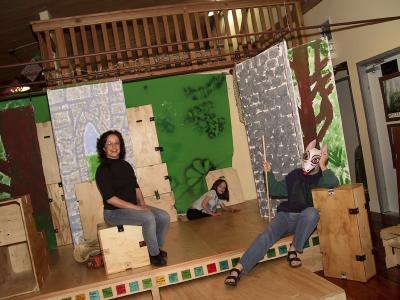June 26, 2003
Set change gets applause as student’s design debuts
So familiar is the amateur theatrical production, that it’s practically an American rite of passage for young schoolchildren.
Earlier this month when grade school students at University Cooperative School performed A Midsummer Night’s Dream all the elements were in place. The players had a fresh enthusiasm for their work and skinned knees beneath their costumes. Overpaid stars and overblown egos were nowhere to be found. And the audience was largely proud parents.
But there was a moment that made this night much different for a group of UW students who were also in attendance.
“The audience spontaneously applauded for a scene change,” Louise St. Pierre recalled, reflecting on how students from her industrial design class felt that night. “The play started and that was magical enough. Then the lights went down and the children came up and started moving the set around. It was just so amazing how quickly it happened and how magical it was that the audience just burst into applause.”
St. Pierre’s students were on hand to witness the debut of a stage they had spent the quarter designing and then building. When the quarter began they were a rag-tag group of mostly sophomores in the School of Art. By the time it was all said and done they had worked with a group of elementary school students to produce a stage that any small school would envy. Along the way they learned valuable lessons about working as a team and listening to the client.
And, of course, they savored that one moment.
“The first time the kids changed the scenery we were just stunned,” said Christine Lee, one of St. Pierre’s students who worked on the project. “We got so excited because we saw that it worked.”
The stage worked and, more importantly for St. Pierre, so did the process. Students at University Co-op contributed from the beginning. They wanted the stage to accomplish specific things — it needed to be kid friendly, it had to be versatile, and it had to have a trap door.
“People often try to do this and they write about it,” she said. “There’s a whole academic group that talks about this sort of partnership constantly. But quite often it ends up feeling incomplete. You know, you get a little bit of input from the kids and then you go ahead and do what you really wanted to do all along.”
That was not the case this time around. One teacher at University Co-op, St. Pierre said, was so moved by the sincerity of the collaboration that it brought her to tears. The third-, fourth- and fifth-graders appreciated the spirit of the project too.
“It was something I heard from them on a number of occasions, ‘They used my ideas. They put my ideas into this project.’ ”
Or as one of the young students put it, “It felt like they thought we were real human beings. It felt like they thought we were designing with them.”
The college and elementary students began meeting early in the quarter. They divided into five teams and got to know one another. Then, together, they came up with some ideas for a stage. At a later meeting the UW students showcased five proposals. University Co-op students voted for elements from each design that they wanted to see in the final stage.
The UW students went back to the drawing board and presented another proposal. It was a thorough and collaborative process, but finally they were ready to begin work on the stage.
“It was amazing how detailed and articulate the kids were with their ideas,” Lee said. “They’d look at the design and offer specific changes.”
In fact, she said she had to fight the urge to just get to work constructing the stage.
“That really wouldn’t have been the best way,” she said. “You really do have to go through that design process.”
The performance was scheduled for a Wednesday and Lee said they were still putting finishing touches on the stage on Tuesday. They finished the project in time at a cost of about $1,400.
The stage features two pullout islands that can be hidden under the main stage or extended to create a much larger space. There are wood blocks that are held together with recycled seat belts. Depending on how they are set up the blocks can become anything from a couch to a podium. And there is a trap door that extends from backstage to the main stage and off to the other side of the set. Scenery is painted on canvas flats that hang from a series of pipes constructed to extend across the length of the stage when needed and then tuck away out of sight after the performance.
It’s an impressive addition to the newly renovated school building. St. Pierre gives all the credit to her students and the late nights they spent working in the design studio to finish the project. She said they gave her an indication early on that the project would be successful.
“Right away my students said that their idea of failure would be if they disappointed the U. Co-op kids. So their hearts were totally into it.”



